
by Sujata Gupta Friday, March 1, 2013
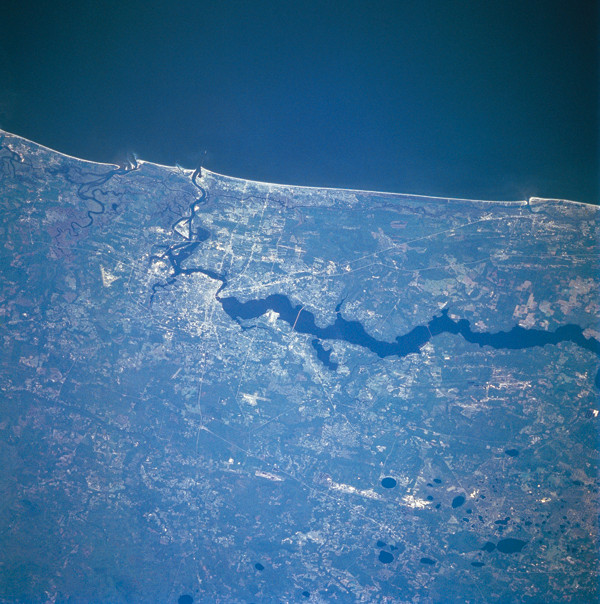
Sinkhole lakes dot the landscape of northeastern Florida near Jacksonville. NASA
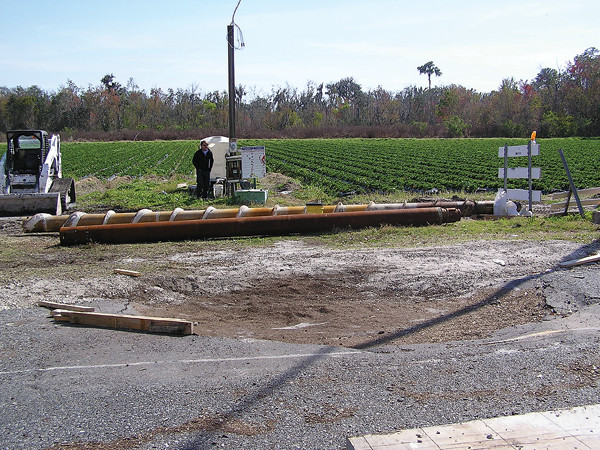
One of more than 130 sinkholes that formed in Florida last winter (2009). Southwest Florida Water Management District
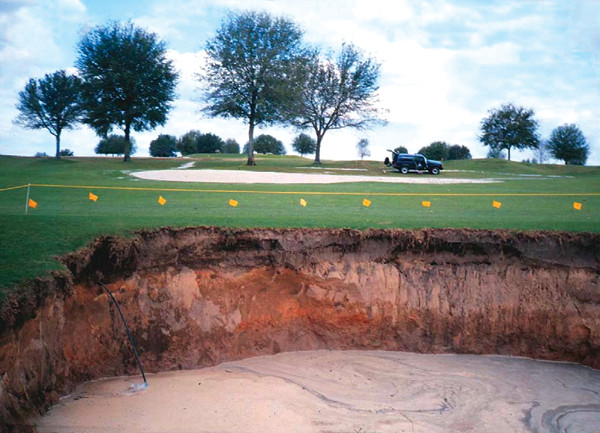
Southwest Florida Water Management District
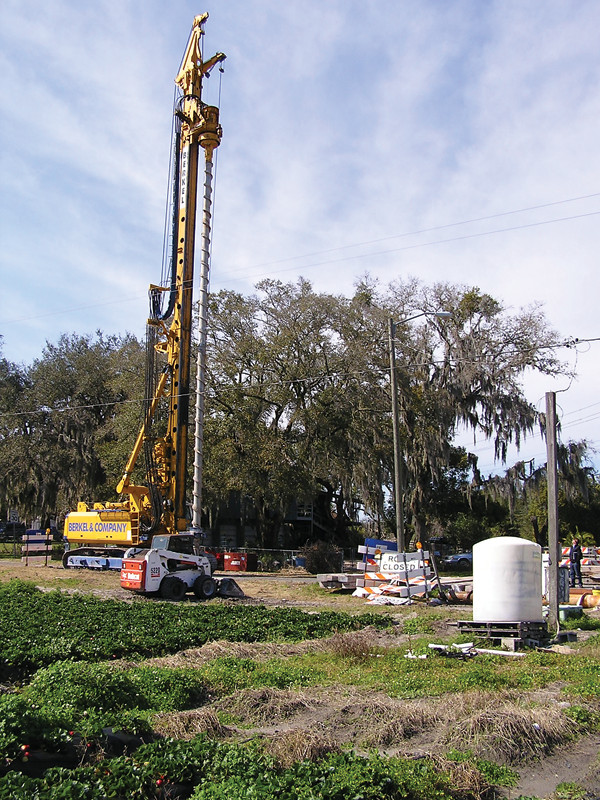
Sinkholes closed roads in west-central Florida last January (2009). Southwest Florida Water Management District
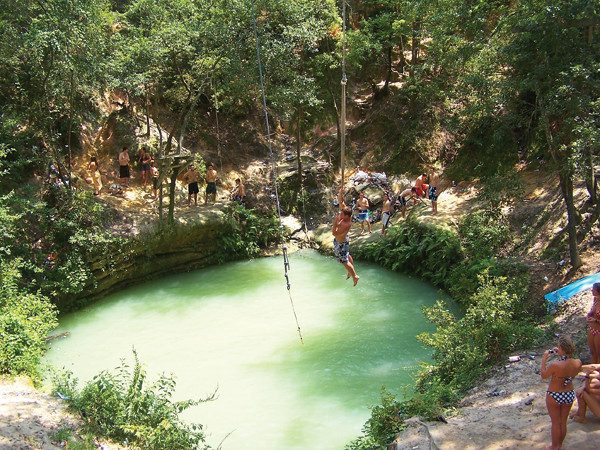
A sinkhole near Hawthorne, Fla. Alexander Landfair
This story was printed in August 2010. In response to the tragic sinkhole event in Tampa, Fla., on March 1, we are reposting this story.
January in Florida tends to be dry and chilly, with only a few days dipping below freezing. This winter, however, temperatures in west-central Florida dipped below the freezing point for 11 straight days, making 2010 Florida’s coldest winter in 80 years. To prevent their crops from freezing, strawberry and citrus farmers sprayed their fields with water for days on end.
About 90 percent of Florida residents and farmers get their water from aquifers, interconnected pore spaces in permeable carbonate bedrock. Most people in the state tap into the top part of the Floridan Aquifer, which underlies all of Florida and parts of the surrounding states. Last January, the parts of the Upper Floridan Aquifer in west-central Florida where strawberry farmers are concentrated saw the groundwater level plummet a record 18 meters. Wells ran dry. Then disaster ensued: Sinkholes formed across the region.
In a normal January, there are only a handful of sinkholes in southwestern Florida, according to the U.S. Geological Survey (USGS). In 2010, though, about 130 sinkholes formed across the region — some in dangerous places, such as under roads or homes. In January, for instance, a portion of busy Interstate 4 between Tampa and Orlando caved in, rerouting traffic for weeks and costing $9 million to repair.
Though often a nuisance, sinkholes are a natural part of Florida’s landscape, forming when rainwater levels fluctuate, says Mark Stewart, a geologist at the University of South Florida in Tampa. But Florida’s population has increased from fewer than 8 million in the 1970s to just shy of 20 million today — and farmers, snowbirds and Mother Nature have begun to engage in an increasingly acrimonious water war. Water levels naturally fluctuate across the ages. But now, with the addition of humans to the landscape, the situation has become increasingly volatile. “In a sense,” Stewart says, “nature and geology have loaded the gun, but humans can pull the trigger.”
The precursors for sinkholes arose more than 100 million years ago, when the Florida peninsula was submerged beneath the ocean. As the ocean over Florida became shallower, mollusks and calcareous algae began to inhabit its waters. Their remains accumulated into carbonate rock called limestone, and eventually formed shallow reefs. Over tens of millions of years, Florida remained isolated and partially submerged, much like the Bahamas today, and thousands of feet of limestone accumulated in its warm, shallow waters. As more time passed, a channel between Florida and North America closed and sand and clay that had eroded off the Appalachian mountains settled atop the reef. This created a topographic layer cake with sand and clay sandwiched between the limestone.
Today a top layer of sand and clay overlies the carbonates below. (Without this sand and clay layer, Florida would look much like the Yucatán Peninsula, with large, open sinkholes called cenotes.) Rainwater percolates through the sand and clay at the surface and into the underlying limestone layers. But the circulation of slightly acidic groundwater (which forms naturally when rainwater meets acidic soils) slowly dissolves the limestone. Over time, the limestone becomes riddled with cavities, Stewart says. “It wouldn’t be an exaggeration to call some areas underlying Florida ‘Swiss cheese.’”
Typically, Florida’s aquifers are nearly saturated, with water filling pore spaces in the carbonate rocks below and the soil layers close to the surface. But when the water is removed quickly — as happened in January — water levels plummet and the framework of soils and rocks weakens as the system is depressurized. Water pressure changes can cause overlying soils to cave inward. With a rapid enough drop, the surface water cannot recharge the local aquifer fast enough and gravity’s work becomes apparent: sinkholes.
Sinkholes that form due to the natural variations of groundwater evolve slowly, over centuries. The area that eventually becomes a sinkhole goes through multiple wet and dry cycles, which gradually dissolve the limestone. When the weight at the surface is too much for the underlying, cavity-filled bedrock, it collapses and forms a sinkhole. Sinkholes haven’t been a big problem for humans until recently, Stewart says. “Before, when a sinkhole opened up in a cow pasture, nobody cared,” he says. “But now it opens up under somebody’s house or under Interstate 4 so we pay attention.”
Now, sinkholes open up seemingly — or literally — overnight. When temperatures are above freezing, much of the blame lies with development projects, which, thanks to Florida’s rapid population growth, are on the rise, Stewart says. The excess weight of development, including shopping plazas, residential developments and roads, strains the already weakened bedrock. Coupled with this weight are artificial surfaces that prevent rainwater from seeping into the soil. Without that rainwater, the cavities in the limestone cannot fill and recharge the aquifer. As a result, the aquifer begins to dry out. With no way to maintain water pressure beneath paved areas, a perpetual “dry season” ensues even during the rainy season, says Terrie M. Lee, a research hydrologist with USGS in Tampa, Fla.
But pavement may not be all bad. Florida is researching how to capture water that runs off of pavement and put it back into the ground, says Anthony Andrade, a reclaimed water specialist with the Southwest Florida Water Management District in Brooksville, a government agency that manages 16 Florida counties. That could increase the water supply, especially for agricultural and industrial use, he says. That could also buoy up the ground by repressurizing the aquifer.
But more development and more people create a vicious cycle, Lee says. The pavement prevents the aquifer from being adequately recharged (even with artificial recharge methods), and more people means more water withdrawal from the aquifer. Though such growth has been concentrated in certain areas, such as Pasco County in west-central Florida, any tinkering with water levels in one part of the aquifer affects the entire state’s water supply, she adds. Because everything is interconnected, the aquifer is very sensitive to both recharge and withdrawal, so pumping at a well in one area prompts water to move rapidly toward the well through the porous aquifer underlying the entire region.
Development and increased water use, therefore, stress Florida’s geologic foundation. But last winter’s deep freeze presented a sort of geologic heart attack. The rapid drop in the aquifer’s water level in west-central Florida during the deep freeze caused sand and clay to fall so fast that 4.5-meter-deep, 6-meter-wide sinkholes — which typically appear one or two at a time —popped up like excited whack-a-moles, Stewart says. When such situations arise, it’s no wonder that many people think the incidence of sinkholes is on the rise — a problem many attribute to human behavior. This has led to a growing sinkhole litigation business, says Richard Powers, a certified professional geologist and president/CEO of BCI Engineers and Scientists, which has offices based in Florida.
Powers, whose company investigates to see if sinkholes have formed under the foundations of people’s houses, says that in the past decade his company went from investigating two sinkhole claims per month to about a hundred. However, Powers says he is doubtful that the sinkhole problem is growing as fast as the increase in insurance claims and lawsuits suggest; he thinks politics and money play a role too.
Until recently, he says, Florida state law mandated that all homeowner insurance policies provide sinkhole protection as a standard part of coverage. A few years ago, insurance companies successfully lobbied the state legislature to make sinkhole coverage optional — a change that just recently went into effect. That means that those who want such coverage now have to pay more. “It isn’t a good idea … but given how high property insurance rates are in Florida, I would guess that some homeowners do opt out,” Stewart says. If they have coverage, homeowners with cracks in their flooring or doors that stick can claim that an incipient sinkhole beneath the foundation of their house is causing the house itself to shift. Those complaints prompt engineers and geologists like Powers to assess the situation and determine whether a sinkhole or something else is encouraging the doors to swing too much and the floors to creak.
To test for sinkholes, scientists use a technology known as ground penetrating radar, which emits an electromagnetic pulse as it scans the ground. An anomaly in the pulse’s return signal can indicate a subsurface void near the foundation of the house. When such an anomaly is found, the next step is to drill holes into the ground to look for subsurface cavities. Most of the time, Powers says, those tests reveal that other factors, such as shoddy construction, poor foundation preparation or clays that naturally shrink and swell — and not sinkholes — are causing the problem.
But even if the evidence suggests that the problem isn’t sinkhole related, ruling out sinkholes as a probable cause is almost impossible, Stewart says. In Florida, there are so many cavities in the subsurface limestone that you can drill almost anywhere and find cavities near the surface, he says.
More than a decade ago, Powers says, lawyers joined the sinkhole fray — and that’s when things really started to change. When residents dispute surveyors’ findings in court, the ambiguity surrounding sinkhole science tends to work against insurance companies and in favor of lawyers and their clients, he says, and therefore insurance companies now often choose to settle out of court. “If it costs $50,000 or $100,000 for insurance companies to settle a claim and if they go to court and it’s going to cost them $150,000 just to litigate the case, they’re better off paying the $100,000,” he says. “So it becomes an economic decision all the way through.”
Even if homeowners willing to sue insurance companies are in the minority, Powers says, the likelihood of winning such a case is helping drive the lucrative sinkhole litigation business. And that, he says, may inflate sinkhole statistics.
But not everyone agrees that sinkhole statistics are too high. There’s little doubt that people — and money — are confounding the delicate task of counting sinkholes, says Ann Tihansky, a geologist with USGS in St. Petersburg, Fla. “Some of the statistics on sinkhole formation need to be carefully scrutinized.” But overall, Tihansky says, it’s likely that development projects, increased water use, and the fear that reporting sinkholes will cause property values to plummet are causing the situation to be under-, rather than over-estimated.
Overall, it’s hard to state the real scale of the sinkhole problem in Florida. Measuring human impact is difficult, Stewart says. Sinkholes are probably on the rise, he notes, but more people are also around to notice them. So an increase in sinkhole observations doesn’t necessarily mean an equal increase in actual sinkhole numbers, he says.
Even though many scientists agree that humans are capable of altering Florida’s entire hydrogeologic framework, that understanding doesn’t make finding a solution any easier, Stewart says. Telling farmers not to spray their crops in winter means potentially driving them into bankruptcy, he says. On the other hand, Lee adds, allowing them to reduce the water level in the aquifer so drastically means Floridians are actually subsidizing farmers and their crops through the taxpayer dollars needed to remediate sinkhole damage.
“How do we solve this problem?” Stewart asks. “We don’t want to kill the agricultural industry, but on the other hand, [homeowners in west-central Florida] have suffered a damage that is directly related to somebody else.”
Ken Weber, a hydrogeologist with the Southwest Florida Water Management District, says the district already requires farmers and others who use a lot of water to obtain water rights permits every 10 years. Following last January’s cold spell, the district has begun considering limiting how much the water levels in the local part of the aquifer can drop during a single spraying event. (These levels are recorded at monitor wells.) “This will make strawberry farming a bit riskier in cold winters,” Stewart notes.
The district is also holding a series of meetings to re-evaluate old policies and procedures, as well as looking at alternatives to spraying, such as covering crops to protect them from the elements or spraying crops with biodegradable foam on days that call for freezing temperatures, Weber says. The latter method, for example, is used to protect ornamental crops at Disney World, Stewart adds. But for now, both efforts are “cost prohibitive,” he says. The district hopes to implement an updated plan before next winter, says Robyn Felix, the district’s media relations manager.
But spraying is not the only source of water stress in Florida. The greatest amount of water in the state goes toward irrigation, Andrade says. So the region needs real solutions to address daily water stressors. One such solution that might help is repurposing wastewater, he says: Right now, more than half of Florida’s wastewater is being treated and used for agricultural and industrial purposes. The state also stores rainwater and treated wastewater in underground reservoirs that can be released during a water shortage, Andrade says.
Unfortunately, he says, that water cannot fill depleted aquifers fast enough during a freeze event to prevent a sinkhole disaster like the one that happened this winter. The only way to prevent such a sinkhole disaster, Stewart says, is to reduce the rate at which water is pumped.
Reprinted from the August 2010 issue.
© 2008-2021. All rights reserved. Any copying, redistribution or retransmission of any of the contents of this service without the expressed written permission of the American Geosciences Institute is expressly prohibited. Click here for all copyright requests.